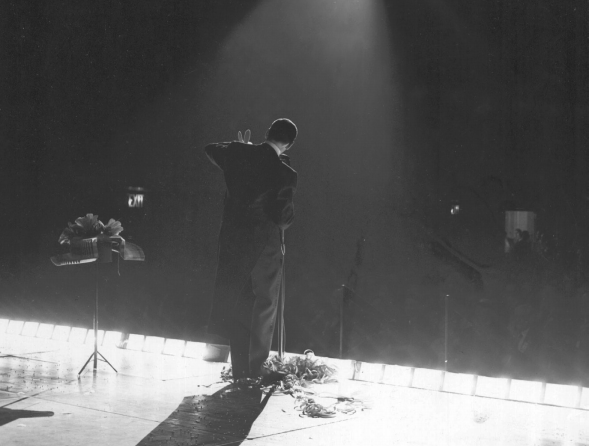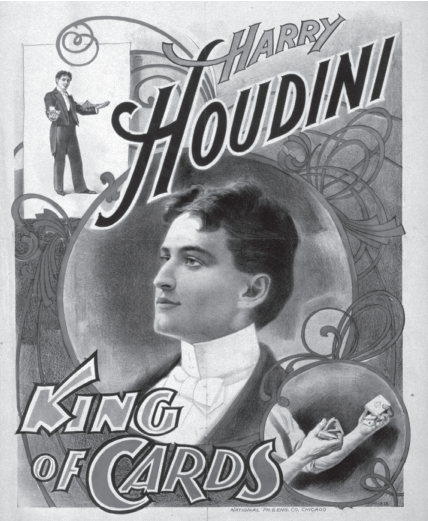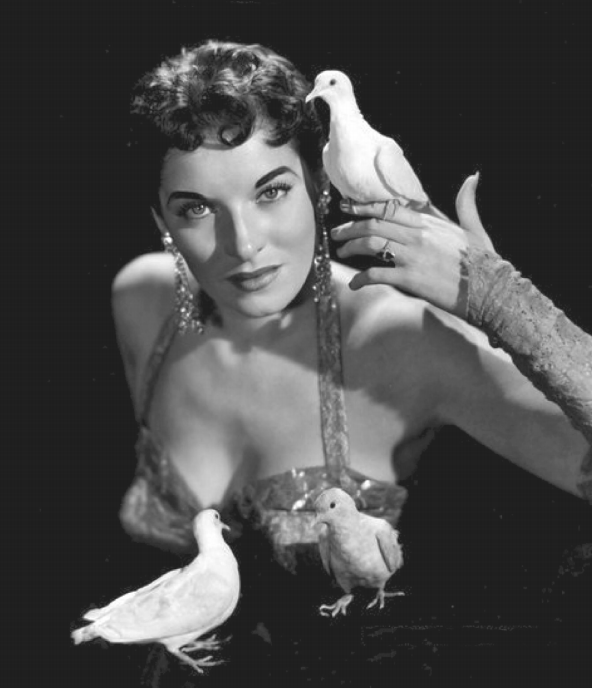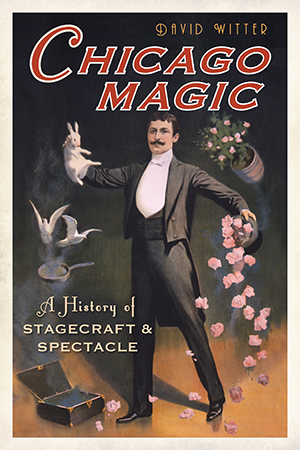
Chicago, that tough midwest city on Lake Michigan, is known for many things, including the meat packing industry, the birthplace of the skyscraper, deep dish pizza, Al Capone, and basketball superstar Michael Jordan. Add one more to that list: magic. Yes, the Windy City makes a strong case for being the hub of twentieth-century magic and home to its share of magicians. Truly, Chicago embraced the community of magicians, extending the welcome mat to card sharps, tricksters, circus freaks, fortune-tellers, and hucksters alike.

before he gained fame as an escape artist. Lithograph poster, C 1895. McManus-Young Collection, Library of Congress.
Houdini in Chicago
In 1893, an eighteen-year-old from Appleton, Wisconsin, named Harry Houdini arrived at the Chicago World’s Fair to perform. What the small-town kid saw was a wealth of other nationalities and cultures, including Chinese, Turkish, African, and Asian. Playing off the public’s fascination with the “other,” Houdini dazzled crowds who loved their “exotic” magic show. After the World’s Fair, Houdini was in demand. He continued to work in Chicago, sometimes working as many as twenty shows a day, perfecting what would become his signature move — the escape. In 1898, Houdini announced that he would escape from both handcuffs (and a Chicago jail). After summoning the media, Houdini stripped completely naked and was searched before he entered. Local cops put him inside a cabinet. After ten minutes, he walked past the reporters waving his arms, a Chicago legend was born, and the rest of the world demanded their own performances by Houdini.
The Thurston Brothers
Also at the 1893 World’s Fair was Howard Thurston, who worked as a barker for the African Dahomey Village. Thurston stood in front of the attraction and shouted to passersby promising a show with savage, untamed, wild natives performing exotic dances. Magic of this era featured irresistible images of demons, devils, witches, floating skulls and boiling cauldrons, and Howard’s younger brother Harry was inspired to create a dime museum on South State Street featuring all the mysterious and wondrous images from magic’s realm. It was basically a stationary carnival freak show. Ticket revenues helped older brother Howard’s ambitious stage show which featured railroad cars carrying expensive equipment, signs, and assistants. Magic had become a vaudeville staple and a booming business in the early twentieth century.
Harry Blackstone Sr.
Ushering in the so-called Golden Age of Magic was Chicago native Harry Blackstone Sr. From 1910 to 1955, Blackstone carried the traditions of Houdini and Thurston in the twentieth century and inspired generations of future magicians. His elegant stage show was more theater than back alley. Dressed in long black “tails” and top hat, Blackstone also benefitted from a long frame that made him a dashing figure on the vaudeville stage. His magnificent charm and stage personality was enhanced by his innovations, including the vanishing horse and the dancing handkerchief. Easily his most famous bit was his floating light bulb illusion, which today sits in the Smithsonian

Celeste Evans
Canadian magician Celeste Evans came to Chicago in 1962, during the so-called Golden Age of Magic, and built a career performing on the banquet circuit and at multiple conventions. Evans also became a star of television, appearing at the Palace Theater and on The Ed Sullivan Show, The Arthur Godfrey Show and To Tell the Truth. Evans shattered the old tradition of the woman in tights working as the magician’s assistants, and even made Chicago mayor Richard J. Daley into a fan. In 1998, she was inducted into the Society of American Magicians Hall of Fame.
“I felt sorry for all those girls who not only had to stand on stage and clap and run little errands, but after the show they would iron the silks and do laundry…They all knew the secrets of the tricks and secrets of the illusions but never performed themselves.” – Celeste Evans

Chicago Magic: A History of Stagecraft and Spectacle
By David Witter
By the end of America’s “Golden Age of Magic,” Chicago had taken center stage in front of an American audience drawn to the craft by the likes of Harry Houdini and Howard Thurston. Cashing in on a craze that rivaled big-band mania, magic shops and clubs sprang up everywhere across the Windy City, packed in customers and put down roots. Over the last century, for example, Magic, Inc. has outfitted magicians from Harry Blackstone Sr. to Penn and Teller to David Copperfield. Magic was an integral part of Chicago’s culture, from its earliest venture into live television to the card sharps and hucksters lurking in its amusement parks and pool halls. David Witter keeps track of the shell game of Chicago’s fascinating magic history from its vaudeville circuit to its contemporary resurgence.

